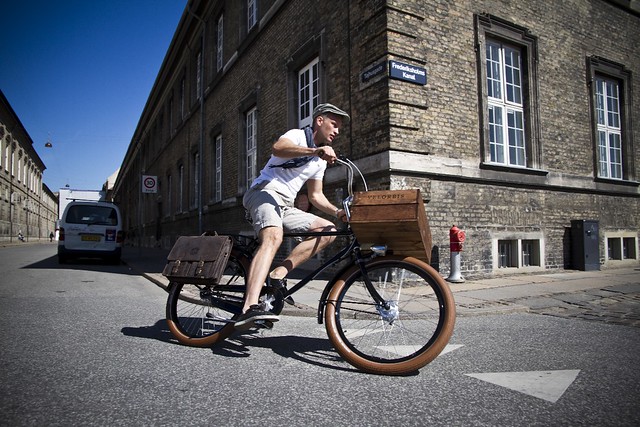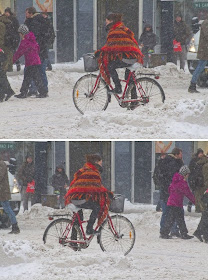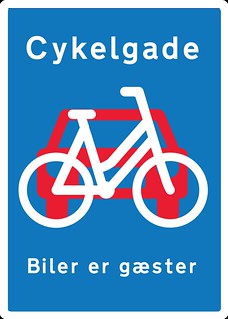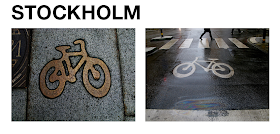
 The Bicycle as a symbol of progress, of renewal, of promising times ahead. This is not a new concept. Indeed it has been around since the invention of the bicycle. Many bicycle posters at end of the 19th century featured promising themes like liberation, progress, freedom. Here’s an example:
The Bicycle as a symbol of progress, of renewal, of promising times ahead. This is not a new concept. Indeed it has been around since the invention of the bicycle. Many bicycle posters at end of the 19th century featured promising themes like liberation, progress, freedom. Here’s an example:
 In this beautiful poster, there is a lot of metaphorical gameplay. The young woman is riding a bicycle to the future. Dressed in white and seemingly casting fresh flowers as though leaving a trail for us to follow. The old woman is looking backwards to the past as she sits in a bed of thorns, almost resigned to the fact that the future - the bicycle - is passing her by. When people in most cultures see art or photgraphy, our brain sees movement from left to right and interprets the piece based on that.
In this beautiful poster, there is a lot of metaphorical gameplay. The young woman is riding a bicycle to the future. Dressed in white and seemingly casting fresh flowers as though leaving a trail for us to follow. The old woman is looking backwards to the past as she sits in a bed of thorns, almost resigned to the fact that the future - the bicycle - is passing her by. When people in most cultures see art or photgraphy, our brain sees movement from left to right and interprets the piece based on that.
The German historian and psychologist Rudolf Arnheim who wrote, among other books, “Art and visual perception – A psychology of the creative eye” noticed that the way many cultures read - from left to right - has an influence on the way we look at art or photography.
‘Since a picture is “read” from left to right, pictorial movement toward the right is perceived as being easier, requiring less effort’.
Bicycles often look better when heading off to the right. In the photo shoots we’ve done for bicycle brands, we are always careful to shoot the right side of the bicycle wherever possible, so that the chainguard is visible. It just looks better with the chainguard in the shot, but it also looks better heading to the right.
Photo shoot for Velorbis catalogue.
Here are a couple of examples of ‘reading’ a photo. At top left, the girl in the poncho looks like she is struggling into a snowblown headwind, which she was. At bottom left, by flipping the photo horizontally, she looks like she is sailing on a tailwind. The pedestrians, as well. At top right, the bicycle users appear to have an easy go of it with a tailwind. Which they weren’t. At bottom right they appear to be muscling into the snow and wind.
The flag at the top is the party flag for the Samajwadi political party in India. In 2012, their rising star, Akhilesh Yadav, won a landslide election in the Uttar Pradesh state elections. Yadav campaigned tirelessly and he rode hundreds of kilometres around the state on his bicycle and organised bicycle rides. Reuters has an article about his rise to power. He thrashed the heir-apparent in Indian politics, Rahul Ghandi by appealing to the working classes, sleeping in villagers huts and aligning himself with the demands of the regular citizens. And the man can even text and cycle at the same time. He’s got our vote.
So a bicycle is a fitting symbol for the party. For any progressive party who aspire to be agents of change. I have no idea if the designer thought about the positioning of the bicycle on the flag at the top. Based on this Left to Right perception, the bicycle isn’t heading away from us, carrying us to a better future and all the other metaphors you can think of.. The positioning of it - in our perception - suggests that it is going in the opposite direction. Going against the flow, or against the grain, as it were. Which can be symbolic in a positive sense for a political party wishing to embrace change and deconstruct the status quo, but that’s far too subliminal. Interestingly, on the political party’s Facebook group and elsewhere, there are versions of the flag reversed so it points left to right.
This started out as an article about Mr Yadav and his party’s use of the bicycle as a symbol. A discussion started here at Copenhagenize Design Company, however, about how bicycles are positioned in signage and pictograms.
If we suppose that a bicycle heading from left to right is ‘positive’ symbolism for our sub-conscious perception, then surely bicycle pictograms and signage should feature this directional placement. We all went over the window to look at the Danish standard on the cycle tracks outside and looked at other examples from around us in Copenhagen.
(Clockwise from top left) The Danish standard as dictacted by the Road Directorate is a bicycle heading from right to left, although the logo of the City of Copenhagen’s Bicycle Office - “I Bike CPH” - features a bicycle in the ‘positive’ direction. The logo for The Green Wave in Copenhagen has the bicycle user in “metaphorical direction neutrality” - could be heading towards us or away from us. I’ve always percieved this as the bicycle heading towards me, come to think of it. While the standard for Danish signage is right to left, there are variations. Wayfinding for indicating routes on the national cycling network. On the bicycle seat belts on the train to Malmö, the bike heads right. At bottom right is a vintage sign I cycle past each day, complete with chainguard, fenders and light. Nice. The Danish State Railways tend to use the standard symbol but they are happy to have the bicycle pointing to the right on variations of their signage.
Above are all the traffic signs in Denmark relating to cycling. At bottom left is the signage for bi-directional cycle tracks, which you don’t see often for obvious design reasons. But it’s there like a retro memory, like the man at bottom right sitting upright with a splendid hat - old Danish signage that we miss so very much. All in all, the pictograms are standardised to feature bicycles heading left. The traffic engineer logic is that pointing a bicycle to the left indicates potential collision and serves, in their minds at least, to add a safety element to the road signage. Generally, there is a tendency to have the bicycle heading to the right if the signage indicates access or bicycle-friendly facilities, but this is not carved in stone, apparently.
“Bicycle Street - Cars are guests”
We chose, however, to aim the bicycle left to right in our proposal for signage for Bicycle Streets in Denmark. And, even more importantly, we were tired of all the boy bikes in all the pictograms we see around the world, so we made it a proper sit up and beg design with a ladies frame. We like the idea of the Dutch version of their Fietsstraat signs, featuring a cyclist heading towards you, in front of a car. The design, however, is clumsy and it looks hand-drawn. We developed the above proposal based on existing Danish signage. Interestingly, the Dutch signage isn’t even official signage, but the Dutch put them up anyway and now people think they are. That’s cool.
Farther afield, let’s have a look through the Copenhagenize archives to see what’s up in the bicycle pictogram world.
Looking from left to right, above, the bicycle symbols are right to left in Zurich, Rome, Ljubljana and Mexico City and then it points to the right in Ferrara. In Vienna, at far right, it’s right to left but the crossing signal - one of the funkiest in the world - features a bicycle with casual-leaning cyclist looking right at us. Which sends positive connotations.
In Berlin we spotted what we assume is a vintage design, at left, featuring a chap wearing a suit and riding a normal bicycle. Citizen Cycling indeed. On street and on the parking sign, the bicycles are right to left.
Stockholm can’t seem to figure out which way to go.
Nor can Trondheim. Even in Amsterdam they have some variations and varying directions.
In Barcelona, the signage is usually right to left, but left to right on the trains. Suggesting access - supported by the word “access” in three languages, just to be sure you get it.
The Finns work with the right to left concept, as does Antwerp - although they switch it around on the green sign. In Budapest, activists made their own pictogram and spraypainted it on streets all over the city. Great idea, although might have been symbolic to reverse the pictogram.
In Melbourne and on official signage in Riga (is that the world’s shortest stretch of bicycle infrastructure?) it is right to left. The bike share in Riga, however is left to right, as is the sign on the door to the train station. The biggest warning on that sign tells you to watch out for the grates if you’re wearing high heels. In Tokyo, right to left.
Brazil is a bit confused. At left is a somewhat standard pictogram in Sao Paulo showing the route for the Ciclofaixa each Sunday. The yellow symbol was made by activists - featuring an upright bike heading in the positive direction. On the second-last photo, the sign stating that Volkswagon sponsored the bike lane through a park has the bicycles heading left to right. And yes, we love that irony. The middle photo is from Rio de Janeiro with a rare example of a pictogram straight on. And the pictogram at the right is a newer version that I’ve seen in use in the city. Nice design, too.
It’s a signage free for all in Canada, with different variations across the land. In the US - the only country to put plastic hats on their pictogram people, there is a general standard and it sends cyclists back out into traffic. In New York, this pathway has reversed them in order to show wayfinding.
The French are sending the bicycle backwards, then forwards to a progressive future and then back again. It’s all very confusing, although their national standard is the white bike on green.
While some countries still need a national standard and there is an ocean of variations, there are still some people who get it hopelessly wrong. We spotted this, at left, in London in June 2014. It’s hilarious. It’s a Jackson Pollack interpretation of the British pictogram. At right, even the Copenhagen Metro can screw up. Lovely that it is a step-through frame, but seriously… how many things can you find wrong with that pictogram? So, after all that, here’s a crazy Copenhagenize idea. Let’s get all subliminal. Let’s flip our bicycle pictograms on the streets and signage to send a sub-conscious message to all those who ‘read’ them. It’s an inexpensive solution to influence perception of cycling. Think about it when planning your logo.
If, as we mentioned above, ‘since a picture is “read” from left to right, pictorial movement toward the right is perceived as being easier, requiring less effort’, THAT should be the general message on all bicycle pictograms. Send the bicycle from left to right - not only so we can see the damned chainguard - but to broadcast the symbolism of a progressive future.
In the tapestry of urban life, bicycles weave threads of freedom and sustainability. Their wheels tell stories of mobility, camaraderie, and the joy of movement. But what if I told you that behind the tangible frames and handlebars lies a hidden vocabulary - a silent language of symbols engraved on the very pavement we ride on?
Enter the world of online casinos and slots, where pixels mimic pedals and chance dances with fate. Here, amidst the digital buzz, cycling motifs emerge like fleeting reflections in a puddle in the rain. These symbols - subtle yet powerful - encourage us to explore their enigmatic meanings.
Cycling around the city lifts my spirits, especially when I realize that bicycles contribute to a greener future. Whenever I take a break from cycling, I love to play cycling-themed online casinos. These games catch my attention with the different bike symbols that make each game feel a little bit like a cycling adventure. I love reading reviews of cycling games because they help me choose the best ones that truly fit my passion for cycling. It’s a great way for me to relax and immerse myself in my cycling hobby, even when I’m at home.






.png)
.png)

.png)
.png)
.png)









